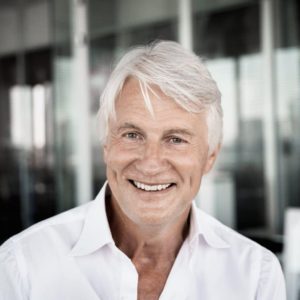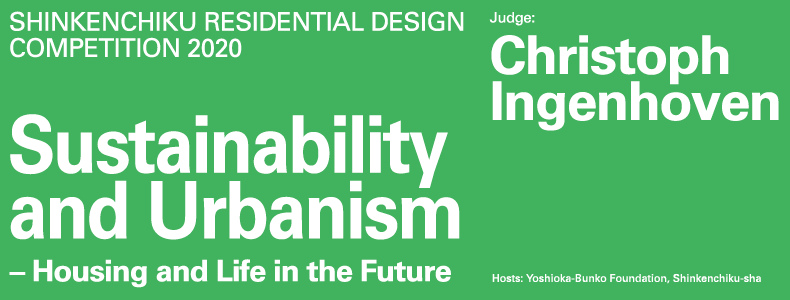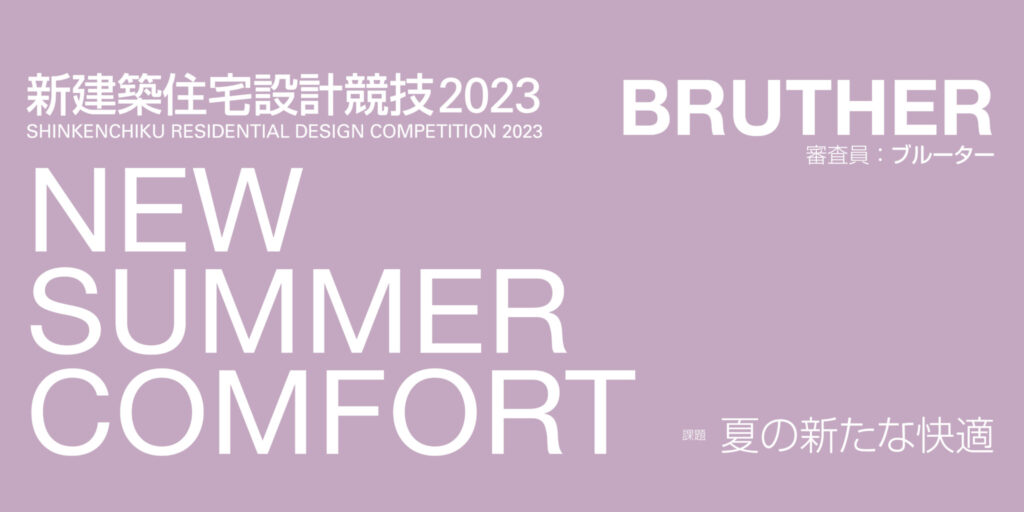Shinkenchiku Residential Design Competition 2020 Sustainability and Urbanism ── Housing and Life in the Future
Theme Sustainability and Urbanism ── Housing and Life in the Future
What should 21st century architecture do? The world’s population will rise to 9.3 billion by 2050. Most of them, if we can believe the prognoses, will live in big cities. Some will live in megacities with up to 100 million inhabitants. At the same time, cities are responsible for 80% of carbon dioxide emissions. In the future, we will require an urban building culture that allows for incredibly dense living. Tokyo, Shanghai or New York are well-functioning contemporary examples. Or do we require a new mode of thinking in the wake of the COVID-19 crisis and the social distancing that ensued? Current events illustrate the vulnerability of such megacities.
There is one certainty, however. We must create buildings and dwellings that allow for us to live in harmony with this planet’s resources again. 50% of the world’s waste and a large part of its energy consumption are caused by constructing and operating buildings. As architects, we can make a decisive difference.
In our efforts to build sustainably, we have focused on purely technical issues for a long time. Today, we must embrace a holistic view. I coined the term "supergreen", denoting projects where the highest sustainability rating are self-evident, and, where aspects are promoted that indirectly count as "green". In ever denser cities, public spaces – or more abstractly formulated – social questions are of essential importance to me. Think about how good architecture can find new answers! The time has come to question the status quo. I am looking forward to unconvential competition entries.
Christoph Ingenhoven
Prize
- WinnerMultiple1,000,000¥
The number of winners and the amount of prize will be determined by the judges.
Schedule
- 2020.06.01 (月)Registration opens
- 2020.09.30 (水)Registration closed
- 2021.01.01 (金)Announcement of the Winner
Guidelines
Entry and Application
To enter the competition, please first register on the competition website. A registration number will be issued by email after the registration form is properly completed. Each applicant should keep a record of this registration number, as it will be needed for submitting your proposal. If there is any change in the registered personal information, re-registration is required. Also, if the applicant wishes to submit multiple proposals, it is necessary to obtain a registration number for each proposal.
• No inquiries regarding the registration number will be accepted once the number has been issued.
• Registration is only available through the competition website.
• Use of mobile phone email address is not recommended since there might be problems in receiving the registration number.Submission Requirements
Contents: Site plan, floor plan, elevation, section, perspective drawing and axonometric drawing at any scale. You are free to include photograph of a model, detailed drawing, other chart. Your submission should include a descriptive text of your design in less than 250 words in English, which must be in 12 point type or larger. Paste this same text in your submission email. All drawings, illustrations, and texts should be laid out on two sheets of A2 (420×594 mm / 16.5×23.5 inches).
• File format: PDF
• File size should not exceed 10 MB (please combine two sheets in one file)
• The registration number must be used as the name of the PDF file of each design entry (e.g., skc0000.pdf).Submission Procedure
Use your pre-registered email address and adhere to the format described below.
1) Email subject line should read: “0000 (your registration number) / Shinkenchiku Residential Design Competition 2020”.
2) Attach your submission file. Be mindful of the file size. Files that do not meet the specified requirements will not be considered.
3) Your email should include the following information: the registration number / full name, age, and profession of all the team members / team leader’s home address, telephone number, fax number (if available), and email address / a descriptive text of the design in less than 250 words.
Note: The amount of emails right before the deadline may overwhelm our internet server, so please do not wait until the last minute to submit your entry. The competition hosts will take no responsibility for submissions that arrive late due to technical issues and will not judge such submissions.Announcement of the Winner
Winner(s) will be announced in the 2021 January issue of SHINKENCHIKU (published on Jan 1, 2020) and a+u (published on Dec 27, 2020) magazines, their digital issues and on the competition website.
Notice
• Copyright of the proposal belongs to the applicant, while the publishing right belongs to Shinkenchiku-sha Co., Ltd..
• Submitted proposals, regardless of the result, may be published on the competition website.
• Questions regarding the competition regulations will not be answered by the hosts. All matters not covered in the regulations listed above are left to the discretion of the entrants.
• Proposals must not have been made public previously in any form. The work must not (in total or in part) infringe on anybody’s copyrights. Do not use images copied from magazines, books, or websites. If a copyright infringement is discovered, the prize may be taken back at the host’s discretion.
• The winning entrants will be requested to submit high-resolution digital data for publication.
• All fees associated with submissions must be borne by entrants.
• Please double-check the contents of your submission. You will not be allowed to replace your proposal after submission.
• Please avoid corrupted texts and broken links. Please embed all the linked files.
• Entries will only be accepted if they adhere to all the regulations.
Judge
Christoph IngenhovengJury Member
Born in Düsseldorf in 1960. He studied architecture 1978–1984 at the RWTH University in Aachen and 1980–1981 at the Kunstakademie Düsseldorf under Prof. Hans Hollein. He has received his Diploma in 1984 under Prof. Wolfgang Döring. Christoph Ingenhoven is one of the leading international architects committed to sustainable architecture. He is a founding member of architecture societies and federations including but not limited to the German Society for Sustainable Building (DGNB) and the Federal Foundation for Building Culture. Since 1985, Christoph Ingenhoven leads the Düsseldorf architectural office Ingenhoven Architects which has won numerous prizes in national and international competitions. Besides his conceptual work, Christoph Ingenhoven acts as jury member and expert in various competitions and give lectures worldwide.
Comments
Competition 2020 Sustainability and Urbanism: Jury Report

Christoph Ingenhoven Jury Member
What should 21st century architecture do? The world’s population will rise to 9.3 billion by 2050. Most of them, if we can believe the prognoses, will live in big cities. Some will live in mega cities with up to 100 million inhabitants. At the same time, cities are responsible for 80% of carbon dioxide emissions. In the future, we will require an urban building culture that allows for incredibly dense living. Tokyo, Shanghai or New York are well-functioning contemporary examples.
However, current events illustrate how vulnerable mega cities are. Do we require a new mode of thinking in the wake of the COVID-19 crisis and the social distancing that ensued? These are the questions posed to the seventy-eight participants in this competition.
I selected works, which address the important social issues arising from the crisis, and had a remarkable approach to providing answers and solutions. After the first review, I shortlisted twelve projects, which deal mainly with three concepts: Future Housing, Future urbanism and Utopia/ Science Fiction. Multiple entries displayed the integration of design elements that actively contribute to sustainability or social return. As all selected winners had an individual approach and a different answer to the questions, I chose to award five projects equally and without additional ranking.
I really appreciate all the great ideas and effort that went into the submitted works and hope that we will continue working on the concepts to create answers to the questions of the future.
[124] Ark the shelter for living + working + supply: This project addresses the complex issue of the Covid-19 pandemic and other pandemic events. The proposal on the one hand is part of the highly dense city network but on the other hand provides a complex mixed-use micro community solution that can act independently from the wider community if needed. I appreciated the well-chosen construct of a new way of living+working+supply in populated cities, to cope with potential public health problems, caused by large population aggregation.
[204] House with Growth: This project is a fictional future answer to a rising population. The competitor faces the problem with a self-growing house. The project combines a modular system with a public space and platformed farmland that gives the area build on back to the community.
[146] Artificial invasion of nature: This proposal makes it clear that greening in architecture is mandatory and can be added to existing buildings as such re-greening the city.
[220] Urban Resource House: The forward-thinking proposal presents an urban resource house, which would produce its own resources for a given radius of population. They answer a challenging question how to supply resources to a deifying urban population without compromising the natural environment. Through this concept, they influence the community and the transportation ways, which has a big impact on climate change and sustainability.
[111] Vertical Urban Village: This clever housing unit is an interplay between a lively community and sustainability. This modular system is built on four important concepts: structure, living, farming and public spaces. This concept should encourage resource reusing and energy efficiency. It’s a smart proposal, which could have been further enhanced by integrating working spaces.
[241] Void-Volume: This work is worth a special mention, because of the creative idea facing the society with the problems we have / (recourse’s we spend). It’s not an answer to the questions, but an interesting, attention-grabbing work, which should be appreciated in its development and idea.

